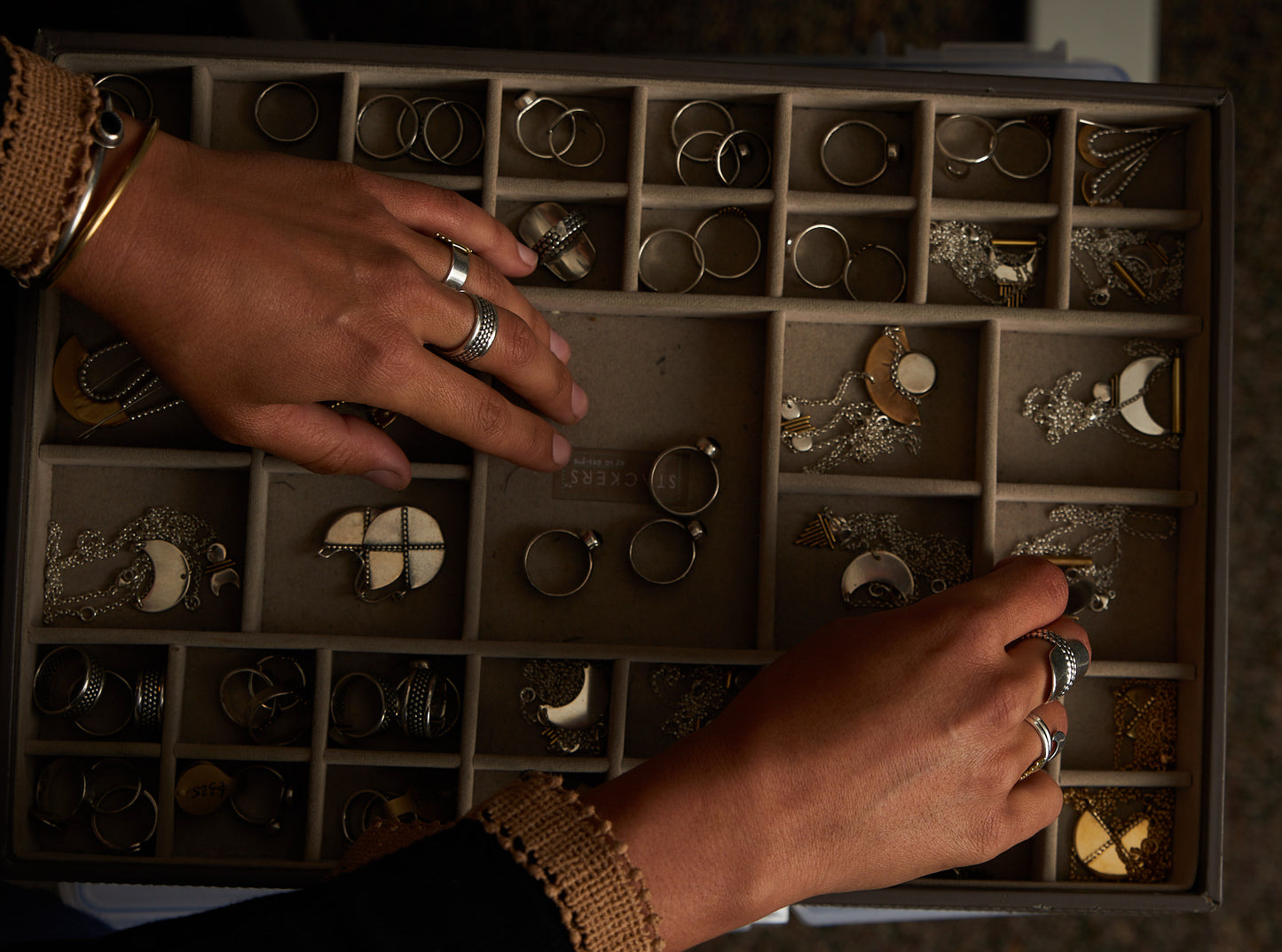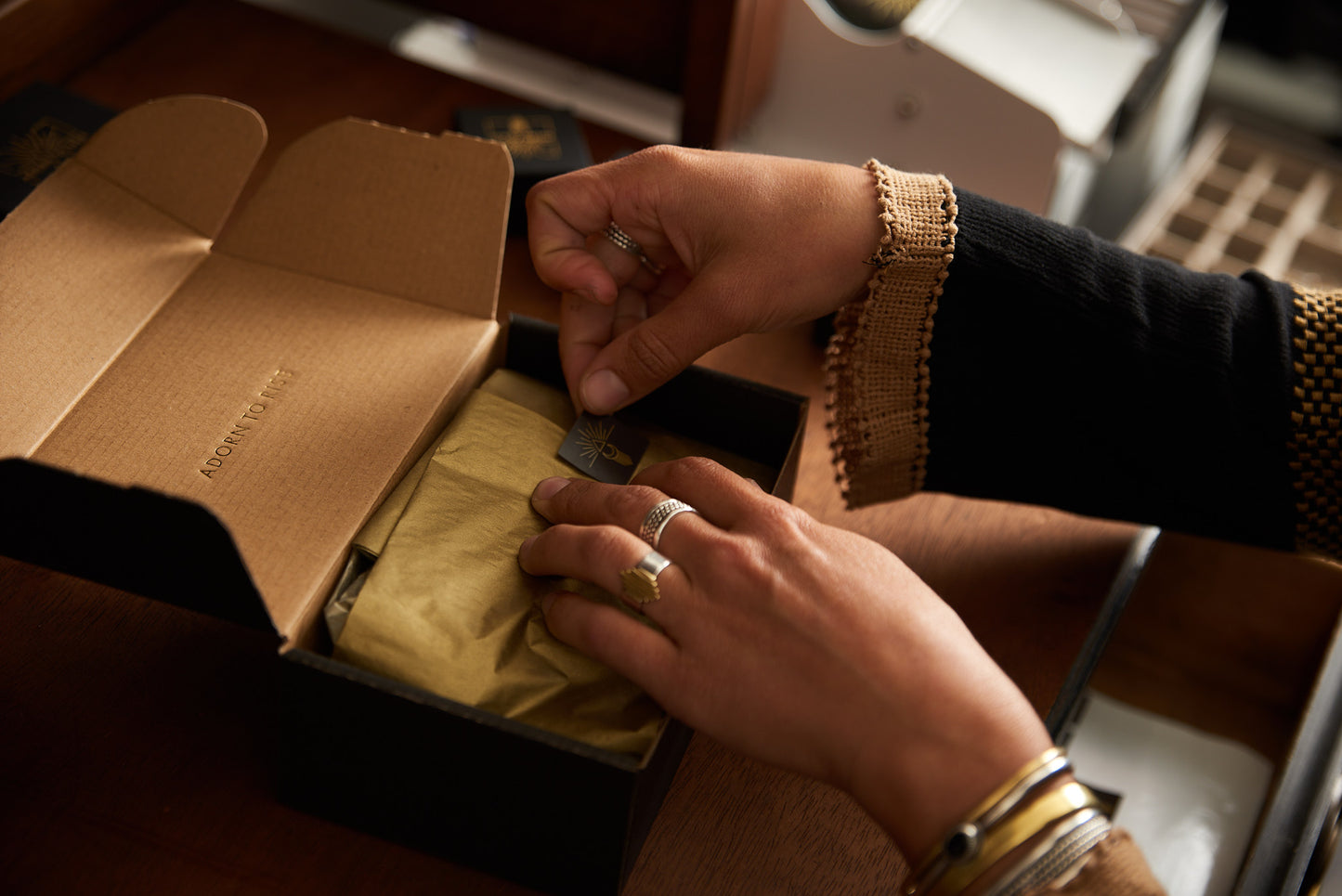
All Adorn to Rise designs are comprised of solid metal. Nothing is plated with a metal or plastic coating. Metal and stone are natural materials, and it is in their nature to react to environments and change over time, just like you. Adorn to Rise pieces are made to be worn regularly, but with the love of everyday wear and tear, nicks, scratches, and even tarnishing can occur. To some, these signs of age is part of the memory of the piece, adds character, and signifies its journey alongside you. But I understand wanting to keep your jewelry bright and shiny so here are some tips to keep your jewelry looking lustrous.

Gold
Gold is highly valued for it's anti-corrosive properties and timeless beauty.
Unlike other metals, gold maintains its luster with minimal tarnishing, making it a remarkably low-maintenance choice for jewelry. With daily wear, the surface of your gold jewelry may develop a subtle matte finish as it accumulates scratches and scuff marks, a testament to its journey alongside you. I encourage you to embrace this timeworn charm as it adds character to each piece, though a gentle polish with a soft cloth can revive its shine.For fine jewelry pieces made with delicate stones and prongs, a rejuvenating soak in hot, soapy water can help restore its sparkle with no damage to any delicate details. While maintaining the allure of your gold jewelry is simple, I encourage you to appreciate the beauty of its evolving patina, a reflection of the memories and experiences it carries.

Sterling Silver
Sterling silver is a bright and beautiful silvery white precious metal.
It is an alloy comprising of 92.5% fine silver with other metals like copper mixed in. Since fine silver, which is 99.99% silver, is too soft and impractical to make jewelry out of, other metals are mixed into an alloy called sterling silver to make it strong enough to endure daily wear. The little bit of copper content in sterling silver is what causes it to tarnish. This is a natural reaction to water, humidity, and oxygen.
Counterintuitively, the best way to keep your silver from darkening is to touch it and wear it. The oils from your skin add a layer of tarnish resistance and can even rub off light oxidation.
To minimize oxygen from interacting with your silver jewelry store your pieces in an airtight bag while you aren’t wearing them.
If you do see some tarnish forming, don’t worry it’s just surface level discoloration and it can be removed by polishing it with a jewelry polishing cloth like the yellow Sunshine Polishing Cloth.

Brass
Brass is an extremely sturdy yellowy gold metal that is a much more affordable alternative to gold.
Brass (like bronze) is a copper alloy. The high copper content in brass can cause it to darken at a faster rate than silver. Again, this is a natural reaction to water, humidity, and oxygen.
Like silver, wearing and touching your brass jewelry is one of the best ways to keep it looking shiny and bright as the oils on your skin naturally polish your jewelry.
If you prefer to avoid the dark patina to the metal, try to keep your brass as dry as possible. Take your rings off when washing your hands and dry your hands thoroughly before putting your rings back on. Avoid swimming with brass jewelry especially in salt water if you want to avoid the Statue of Liberty effect. Keep in mind your jewelry will tarnish at a faster rate in humid climates.
Store your brass jewelry in an airtight bag to minimize oxygen from interacting with it while not in use. If you do see some tarnish, you can polish it with a jewelry polishing cloth, my favorite, is the yellow Sunshine Polishing Cloth.
Some people experience a green coloring to the skin when it comes in contact with brass. This is perfectly harmless and is due your personal PH balance. If it bothers you, you can coat the inside of your ring or bracelet with a clear nail polish as this will form a barrier between your skin and the ring.
Why has my jewelry tarnished?
Sterling silver and brass will naturally develop a patina over time. This is normal and is not an indicator of “bad metal”. It’s a natural and inevitable process called “tarnish” or oxidation which occurs when metal interacts with water, humidity, and oxygen. Some people like the antique look of a little tarnish but if your jewelry has darkened and dulled too much for your liking, no worries, it is just a surface level discoloration and can be removed easily with some care and attention.

Cleaning Methods
Polishing Cloth | Most people keep their jewelry looking shiny and new by giving it a polish every once in a while with a polishing cloth. Polishing cloths are available at most bead stores or can also be found online. They are a soft cloth impregnated with a jewelry specific polishing compound. I recommend the yellow Sunshine Cloth to maintain a shiny finish. You may want to give your piece a rinse with water and pat dry afterwards to clean off any residue the polishing compound may have deposited. Also, take note that when the cloth has turned black, the polishing compound has been used and needs to be replaced.
Steel Wool | In the event that extreme tarnish has occurred, a very effective method that involves less elbow grease is to scrub your jewelry with 00-grade steel wool. Make sure you are only doing this on solid metals as it is abrasive enough to take off plating! Steel wool can be found at your local hardware store. Once you have your steel wool rip off a small piece and wet it with water and household soap. rub it on the surface of your jewelry and rinse off. Pat dry with a lint free cloth and then follow up with a polishing cloth.
Hot Soapy Water | A great method for super delicate jewelry or fine jewelry is to soak it in a bath of hot, soapy water for about 20-30 minutes. Make sure to pat dry with a soft cloth afterwards.
Storage
It is recommended that whenever you are not wearing your jewelry, store it in an airtight jewelry box, cloth, or plastic bag to help slow down the natural process of oxidation.

What to Avoid
- It is recommended to remove your jewelry before sleeping, showering, or excessive sweating, or using harsh cleaners, in order to preserve the finish of your pieces.
- Take care to remove your jewelry before applying lotion, sunscreen, or fragrance to avoid discoloration.
- Keep adjustments of cuff bracelets to a minimum. The more you bend metal the more rigid it gets and it can eventually break. While I design with quality and longevity in mind, handling your jewelry with care is what will make it last a lifetime.
- Avoid storing your jewelry in the bathroom or where moisture is present as it will quicken the tarnishing process. *Note: coastal climates will quicken the tarnishing process due to the moisture in the air. If you live in a marine climate you may want to be extra diligent to store your jewelry in a box or a bag and you may have to polish more often.
- Do not wear your jewelry where chemicals like bleach or chlorine are present such as a pool or hot tub. Also be aware that if you enter a hot spring with a high sulphur content it can turn your jewelry black! Don't worry this is not permanent and can be removed by polishing.
Fun Fact: using sulphur is actually a method I use to intentionally darken my silver jewelry.





